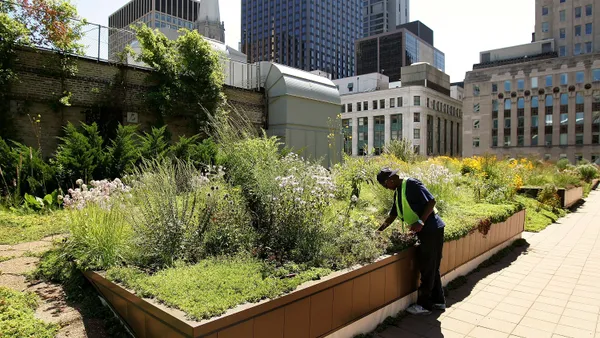Dive Brief:
- The Dallas City Council this week unanimously adopted the city's first urban forest master plan, with 14 recommendations for a unified approach to build a resilient and equitable urban forest. They include ensuring city regulations support tree canopy preservation and growth, maximizing investment in urban forest programs and management, and creating a city storm response and recovery plan. Improved air quality and reduced temperatures are among the most sought-after benefits.
- The plan, which the nonprofit Texas Trees Foundation created, notes that Dallas is already the nation's ninth-most-populous city and is poised for further development. That development threatens to remove tree cover from Dallas' southern neighborhoods, which could create new heat island effects that affect a significant number of economically and medically vulnerable residents, the authors wrote.
- A key impetus for this plan was an earlier heat island management study by the foundation that found Dallas is heating up faster than every other U.S. city except for Phoenix, said Rachel McGregor, urban forestry manager at Texas Trees Foundation. The report cites data indicating that by 2050, Dallas could have 30 to 60 additional days over 100 degrees F per year.
Dive Insight:
As cities across the U.S. report experiencing longer stretches of higher temperatures, they're considering how greater urban tree resources might mitigate the heat.
Los Angeles, for instance, in 2019 created a city forest officer position with a Southern California urban forestry expert specifically focused on managing the city's urban forest.
On the opposite coast, in New York City this week, a group convened by The Nature Conservancy called the NYC Urban Forest Task Force released an NYC Urban Forest Agenda with a stated goal of achieving 30% canopy cover by 2035. The agenda seeks foundational steps, such as creating an urban forest master plan and cultivating urban forest careers, in addition to management strategies like strengthening tree regulations, establishing incentive programs and setting up wood waste reuse projects.
The Dallas master plan follows state of the urban forest assessments in 2015 and 2019 and the release of Dallas' Comprehensive Environmental and Climate Action Plan in 2020, which has a goal of increasing the city's tree canopy to 37% by 2040. Given Dallas' 14.7 million existing trees, that figure currently stands at about 32%, which the report states is "relatively high for a city of its size." It also notes, however, that "the inequitable distribution of tree canopy across the city cause some of its residents to be deprived of the key benefits of these trees altogether."
The urban forest master plan sets Dallas up to soon carry out an inventory analysis, assessing characteristics like the age and species of trees, while also outlining the need for an urban forest management plan.
Dallas is facing an increasing number of high-heat days, defined as those above 100 degrees F. The number of days crossing that threshold rose 58% between 1960 and 2019, with 2011 representing a high mark, when the city experienced 71 high-heat days. Some 40% of Dallas is covered by impervious surfaces and non-vegetated cover, such as roads and buildings, that create a heat island effect. Those factors make the city more susceptible to heat-related illnesses and mortality as well as hazy skies, the report states.
Texas Trees Foundation cited findings from a 2017 study it conducted on heat island management in saying tree preservation and planting is the most effective strategy to lower temperatures in Dallas, with trees reportedly reducing temperatures by up to 15 degrees F in some areas of Dallas.
The plan points to previously proven benefits of urban forests: higher standardized test scores at middle schools, decreases in violent crimes, improved mental health and even shorter hospital stays for patients with views of trees. Parts of the plan also appeal to residents' pocketbooks: The authors say adjacent woodlands can increase property values, and trees planted strategically around homes can reduce energy bills by up to $250 per year for the average household.












